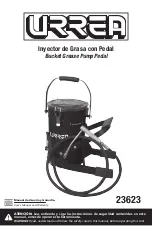
17
9-2 Setting of the supports
1. When in the lowest position, the swing arms can be swung around freely. Swing, extend, and retract
the swing arms for adjustment so that the supports will reach the correct lifting points to suit the
vehicle.
2. Turn the supports and adjust the height of each support rubber pad to lift up the vehicle horizontally,
to apply load evenly to all the four supports, and to push the support rubber pads to the lifting points.
*Use the lift with the height of the four supports adjusted to apply load evenly to them.
Under uneven load, the supports may be dislodged, causing the vehicle to fall.
*Be sure to set the supports to the correct lifting points.
If not set securely, the supports may be dislodged, causing the vehicle to fall or be
damaged.
*Any damaged or worn support rubber pad must immediately be replaced with a new one.
Failure to comply may cause the support to be dislodged, resulting in falling of the
vehicle.
For the correct lifting points of a specific model of vehicle, refer to its maintenance manual.
*In some types of vehicles, the parts below the doors are likely to be hit by the swing arms,
etc.
In such a case, set the support adjusting screws to proper height before use.
*Spread the swing arms as wide as possible before use.
*To lift up an RV or a small truck, use dedicated frame attachments. An attempt to lift up
such a vehicle using the supports for passenger car may cause the supports to be
dislodged, resulting in falling of the vehicle.
In the case of a passenger car, the lift is usually used with the support rubber pads
pressed on the side sills (welded mating faces) in the lower part of the body. Use the lift
with each side sill engaged in the slot in each support rubber pad.
■Reference■
Warning
Caution
Cautio
Содержание NSA3500N
Страница 38: ...37 MEMO...
Страница 39: ...38 MEMO...
















































